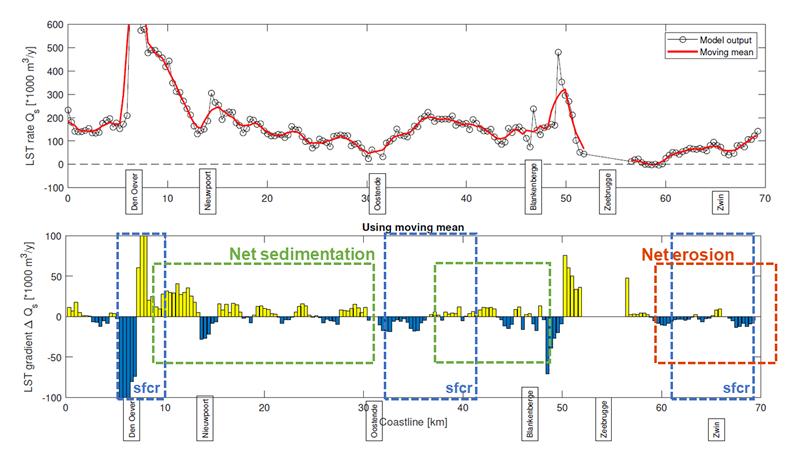S.J. Geerts1*, B. Röbke2, B.J. Geurts1
1 University of Twente; 2 Deltares
*corresponding author:
Introduction
Along the Belgian coast, multiple shoreface-connected ridges (SFCR) are present. Numerical models are developed to capture the hydrodynamics and morpho-dynamics of the nearshore region (Röbke & van der Werf, 2022). These models suggest that the SFCR interfere with the longshore sediment transport (LST) and predict a strong tidal contribution to LST. This modelling study aims to calculate LST along the Belgian coast using a one-dimensional sediment transport model and to understand these processes by an independent and simplified calculation.
Methods
A 1D LST model is developed in UNIBEST-CL+ using 183 cross-shore depth profiles. This new model provides an independent and faster computation of LST rates. Input for this model is derived from a Delft3D-FM model (Röbke & van der Werf, 2022). A parameter sensitivity analysis on model outcomes and a convergence study on the cross-shore step size are performed.
Results
Large LST rates are mostly associated with large flow velocities in shallow areas. LST gradients indicate a net sedimentation west of Zeebrugge and more erosion east of Zeebrugge, see Figure 1. Four different regions in the tidal contribution are identified, a separation attributable to harbour groynes blocking the tidal flow, with an average contribution of 45% along the whole coastline. SFCR likely cause a supply of sediment at the extension of the shoreface connection, at the lee side of the dominant flood current (northeast of the SFCR). Erosion southwest of the SFCR likely occurs due to flow contraction of the dominant flood current through the channel. The sensitivity analysis shows a large influence of D50 and friction height. However, these results are not uniform along the coast but profile-specific, indicating the need for accurate parametrisations alongshore. Lastly, the convergence study shows the need for accurate cross-shore depth profiles in future models developed in UNIBEST-CL+.

Figure 1: Calculated LST rates (top) and LST gradients (bottom) that can erosion- and deposition locations. The presence of SFCR is shown by blue boxes.
References
Röbke, B. R. & van der Werf, J. (2022): Morphological interaction between the nearshore seabed and the coastline of the Belgian coast (MOZES-project). Preliminary results regarding project task 3 "Hypothesis of natural nourishment via shoreface connected sand ridges". Deltares report, 11207736-002-ZKS-0001. Delft, The Netherlands.
I. Surname1*, F.N. Another-Surname2 , Y. Next-Surname2
1 University Name, Country; 2 Organization Name, Country
* Corresponding author: mail.name@organization.org


